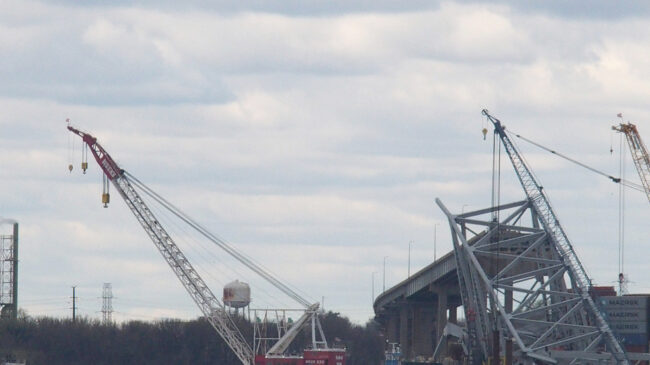Many questions remain unanswered about the ship, the MV Dali, colliding with and causing the collapse of the Francis Scott Key Bridge in Baltimore, Maryland. The biggest short-term priority is the cleanup, which will require dredger vessels to vacuum the riverbed of the shipping channel to clear it of concrete and steel debris from the bridge’s collapse. Unfortunately, the Foreign Dredge Act of 1906 complicates this cleanup process, strains already anemic U.S. dredge capacity, and significantly raises the costs.
The United States Army Corps of Engineers (USACE) has already begun spearheading the cleanup of the shipping channel leading into the Port of Baltimore. The Corps has outlined a three-step plan to clear the debris from the collapsed Francis Scott Key Bridge to ensure the safety of the river and riverbed for incoming and outgoing traffic.
First, teams are prioritizing clearing the steel trusses from the shipping channel to allow one-way traffic to flow back into the Port of Baltimore. Given the estimated $15 million per day loss of economic activity the blockage is causing, clearing the river is the top priority. However, the $15 million number may be too low, given the additional cost of diversion to other seaports across the East Coast for traffic that was already Baltimore-bound. Teams have made steady progress, and temporary channels have been opened.
Second, the cleanup’s priority will shift to removing the trusses, which may need to be cut into smaller pieces to be transported. Barring smaller pieces of debris on the surface that may require cleanup by divers, getting these portions removed would allow the Dali to be moved and the majority of the channel reopened. But there is one more critical step in the cleanup process.
In the third step, the Army Corps of Engineers will deploy some of the country’s undersized dredge fleet to dredge materials that had settled into the riverbed up and over them out of the shipping channel. While the first two steps will largely be conducted by sea cranes and crane ships (which have already arrived, courtesy of the U.S. Navy), the third will require specialized dredging ships.
The costs of this three-step cleanup plan are still unknown due to how early the USACE is in the process, but given the scale of the project, it could be steep. The Washington Post reached out to Peter Ford, founder of SkyRock Advisors, an infrastructure consulting firm, who likened the situation’s complexity to the 2021 Ever Given incident, in which a ship got stuck and blocked the Suez Canal:
“This will be highly technical, very difficult and frankly dangerous,” Ford said. “This size of vessel. This size of bridge. All of the span coming down entirely and some of it still on top of a vessel is a situation that I have never read about in my career.”
While there’s no hard-set cost for the operation yet, the Foreign Dredge Act will undoubtedly raise those costs. The Foreign Dredge Act requires dredgers operating in U.S. waters to be U.S.-crewed, flagged, and built.
Low domestic capacity and a captive market drive dredging costs up for this country in times of crisis, as it has numerous times in the Mississippi River near Memphis during droughts. As I wrote of that crisis, Lou Dell’Orco, chief of operations and readiness at USACE’s St. Louis District, estimated the price of keeping three dredgers in constant operation was “$10 million a month.” If hazardous materials were found to have seeped into the riverbed, dredging would be required for a more extended period to clean the shipping channel properly.
Additionally, low capacity means fewer spare dredgers are available to divert in emergencies like this bridge collapse. In effect, on top of the actual cost of operating the dredgers, there is an opportunity cost paid elsewhere. For example, when a dredger is busy working on the Port of Baltimore, it cannot also be maintaining the draft of the Mississippi. If the fleet were more modern and had more high-capacity dredgers, this problem could also be mitigated.
However, the impact on costs is better shown by an example. The Cato Institute showcased this efficiency disparity by examining two projects. The first project was a coastal restoration project at Whiskey Island, Louisiana, which cost “$118 million to move 15.8 million [cubic yards] of sand.” Meanwhile, in the second project in the Netherlands, “28.1 million [cubic yards] of sand were moved at a cost of $55.5 million.” The project in the Netherlands moved nearly double the dredged material at less than half the cost of the Louisiana project.
The antiquated Foreign Dredge Act of 1906 has long-hindered U.S. port development and slowed recovery efforts in emergencies like this bridge collapse.
As Reason’s Eric Boehm wrote, “The best time to repeal the Foreign Dredge Act was before the Francis Scott Key Bridge collapsed. The next best time to repeal it is right now.”

